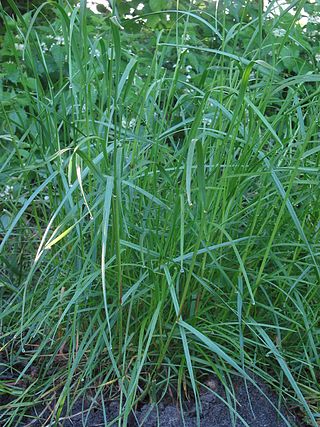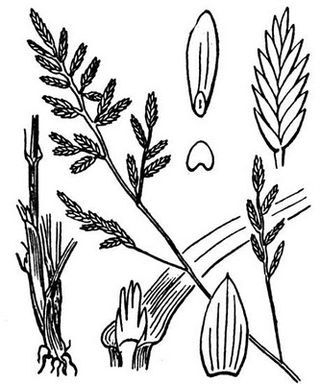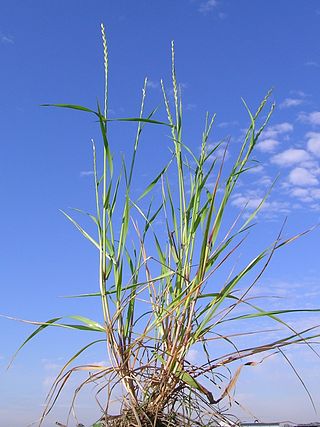
Forage is a plant material eaten by grazing livestock. Historically, the term forage has meant only plants eaten by the animals directly as pasture, crop residue, or immature cereal crops, but it is also used more loosely to include similar plants cut for fodder and carried to the animals, especially as hay or silage.

Lolium is a genus of tufted grasses in the bluegrass subfamily (Pooideae). It is often called ryegrass, but this term is sometimes used to refer to grasses in other genera.

Lolium persicum is a species of flowering plant in the family Poaceae. It is referred to by the common names Persian darnel or Persian ryegrass, and is an annual grass. It has an upright stem, branching from a reddish base, up to 45 cm tall. Its leaves are lower surface glossy, dark green, 6 mm wide.

Festuca (fescue) is a genus of flowering plants belonging to the grass family Poaceae. They are evergreen or herbaceous perennial tufted grasses with a height range of 10–200 cm (4–79 in) and a cosmopolitan distribution, occurring on every continent except Antarctica. The genus is closely related to ryegrass (Lolium), and recent evidence from phylogenetic studies using DNA sequencing of plant mitochondrial DNA shows that the genus lacks monophyly. As a result, plant taxonomists have moved several species, including the forage grasses tall fescue and meadow fescue, from the genus Festuca into the genus Lolium, or alternatively into the segregate genus Schedonorus.

Lolium perenne, common name perennial ryegrass, English ryegrass, winter ryegrass, or ray grass, is a grass from the family Poaceae. It is native to Europe, Asia and northern Africa, but is widely cultivated and naturalised around the world.

Festuca pratensis, the meadow fescue, is a perennial species of grass, which is often used as an ornamental grass in gardens, and is also an important forage crop.

Tragus, commonly called bur gras, burr grass or carrot-seed grass, is a genus of plants in the grass family. It is native to Africa, Australia, and Eurasia with several species on islands in the Atlantic, Indian, and Pacific Oceans plus one species in Argentina.
British NVC community MG6 is one of the mesotrophic grassland communities in the British National Vegetation Classification system. It is one of four such communities associated with well-drained permanent pastures and meadows.

Rhynchosporium is a genus of fungi that causes leaf scald disease on several graminaceous hosts. It includes five currently accepted species: R. secalis from rye and triticale, R. orthosporum from Dactylis glomerata, R. lolii from Lolium multiflorum and L. perenne, R. agropyri from Agropyron, and R. commune from Hordeum spp., Lolium multiflorum and Bromus diandrus. R. commune is one of the most destructive pathogens of barley worldwide, causing yield decreases of up to 40% and reduced grain quality.

Priority is a fundamental principle of modern botanical nomenclature and zoological nomenclature. Essentially, it is the principle of recognising the first valid application of a name to a plant or animal. There are two aspects to this:
- The first formal scientific name published for a plant or animal taxon shall be the name that is to be used, called the valid name in zoology and correct name in botany.
- Once a name has been used, no subsequent publication of that name for another taxon shall be valid (zoology) or validly published (botany).

Festuca arundinacea (syn., Schedonorus arundinaceus and Lolium arundinaceum) is a species of grass commonly known as tall fescue. It is a cool-season perennial C3 species of bunchgrass native to Europe. It is an important forage grass throughout Europe, and many cultivars have been used in agriculture. It is also an ornamental grass in gardens, and a phytoremediation plant.

Lolium multiflorum is a ryegrass native to temperate Europe, though its precise native range is unknown.

Ergovaline is an ergopeptine and one of the ergot alkaloids. It is usually found in endophyte-infected species of grass like Tall fescue or Perennial Ryegrass. It is toxic to cattle feeding on infected grass, probably because it acts as a vasoconstrictor.
Agropyropsis is a monotypic genus of grasses closely related to Catapodium. It is native to the Batna Province in northeastern Algeria, and only contains a single species, Agropyropsis lolium. It once included a second species, Agropyropsis gracilis, which has since been renamed and moved to Lolium canariense.

Catapodium is a genus of Eurasian and North African plants in the grass family.
British NVC community OV23 is one of the open habitat communities in the British National Vegetation Classification system. It is one of six communities characteristic of gateways, tracksides and courtyards.

Festuca gigantea, or giant fescue, is a plant species in the grass family, Poaceae. Because this and other members of Festuca subgenus Schedonorus have more in common morphologically with members of the genus Lolium than with Festuca and often produce fertile hybrids with other Lolium species, Festuca gigantea has been recently published as Lolium giganteum(L.) Darbysh. (1993) and then as Schedonorus giganteus(L.) Holub (1998). Sources vary as to which placement is more acceptable.

Lolium rigidum is a species of annual grass. Common names by which it is known include annual ryegrass, a name also given to Italian ryegrass, rigid ryegrass, stiff darnel, Swiss ryegrass and Wimmera ryegrass. It is a native of southern Europe, northern Africa, the Middle East and the Indian subcontinent and is grown as a forage crop, particularly in Australia, where it is also a serious and economically damaging crop weed.

× Festulolium is a nothogenus of flowering plants in the grass family Poaceae. Naturally occurring hybrids, they are the result of crosses between species of two distinct grass genera, Festuca and Lolium, and the hybrids show phenotypic similarities to both parents. This type of intergeneric hybridization is quite rare, and is indicated by a multiplication symbol before the name. The name Festulolium is an example of a portmanteau word, a combination of the two parents' names.

Clethodim is an organic compound. A member of the cyclohexanedione family of herbicides, it is used to control grasses, especially Lolium rigidum. Although impure samples appear yellowish, the compound is colorless.
















